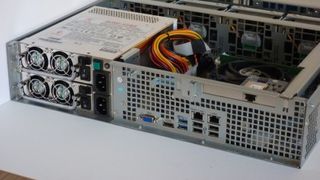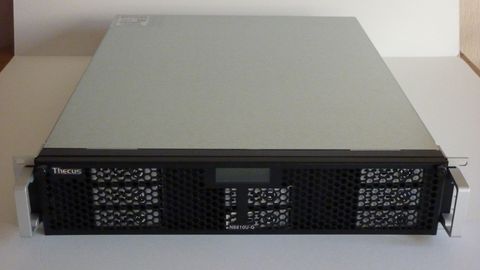Why you can trust TechRadar
Assembling the unit is reasonably straightforward. A massive bag of screws is provided for securing your hard disks directly into the underside of each bay, and they fit in without any trouble. There's no need for plastic sliders to attach to each disk.
A nice addition is the complimentary rail mounting kit, which is usually an extra cost when installing enterprise NAS units like this. It's provided in a separate box, as a set of rails and extra screws, with typically IKEA-like awful assembly instructions.
Another neat feature is the dual redundant 400W PSUs. If one packs up, as they are prone to do, the other will kick in, another way to minimise data downtime.

If only one PSU is in operation, either because you've only connected one of them, or more importantly, if one has failed, the unit warns you with a very loud beeping noise. This is worth remembering, since in a cabinet with lots of other computer hardware, it might not be obvious that the beeping noise is being caused by the N8810U-G's PSU.
With the unit assembled and plugged in, you have to log in remotely to finish the setup and build the array, for the video output is only enabled after installing a separate software module.
Software
Up until this stage I was pretty impressed by the N8810U-G. Plenty of thought has gone into making the hardware extremely flexible and resistant to downtime.
But in many ways, the software isn't as impressive. For a start, the overall faux-3D look of the user interface is dated. It's absolutely functional, but the system isn't the most attractive or intuitive on-board software I've used.
The operating system has been designed so changing most settings can be done without rebooting the unit, which is only to be expected given the focus on minimal downtime. Changing any low-level networking settings, such as IP address configuration, does require a reboot though.
The software provides plenty of useful bits of additional information. When creating the RAID array, hard disks are listed with their firmware versions clearly displayed.
The three Ethernet connections are managed individually, and can be configured with or without static IP addresses.
Hardware AES 256-bit encryption is provided as standard across the entire array. There's also free Acronis system backup and McAfee antivirus.

The list of extra features seems comprehensive. There's Active Directory integration, iSCSI thin provisioning, remote backup, FTP, user quotas, and software expansion modules for BitTorrent downloads and Plex. The N8810U-G is also VMWare 5.5 certified, so you should be able to easily use it as an ESXi datastore.
As with most NAS devices, additional functions are available via downloadable modules. This is an area where competitors seem to have a bit of a leg-up on Thecus.
Messy modules
Installing modules involves visiting the website, browsing the list of available software, downloading it and installing via your browser. You have to check compatibility with the N8810U-G, and while this is all listed on each module page, it feels messy.
A better way would be to integrate the software store with the NAS operating system directly, and only show modules that are 100% guaranteed to work with the N8810U-G.
Some of these modules vary in quality. I quickly installed the BitTorrent module and the interface really wasn't great. It seemed a bit of a chore to upload files and it used quite simple controls, at least compared with the third-party downloader plugins offered on other NAS units.
But despite these small issues, I don't want to criticise the software on the N8810U-G too much. It's no looker, but it's solid and functional.

Nikon Z 40mm f/2 review: this cheap, modern 'nifty forty' has been my every day lens for over a year and it hasn't let me down

Could ChatGPT be the next big cybersecurity worry — researchers say it can crack systems faster than ever before

Meta Quest's software is coming to new Asus ROG and Lenovo headsets
